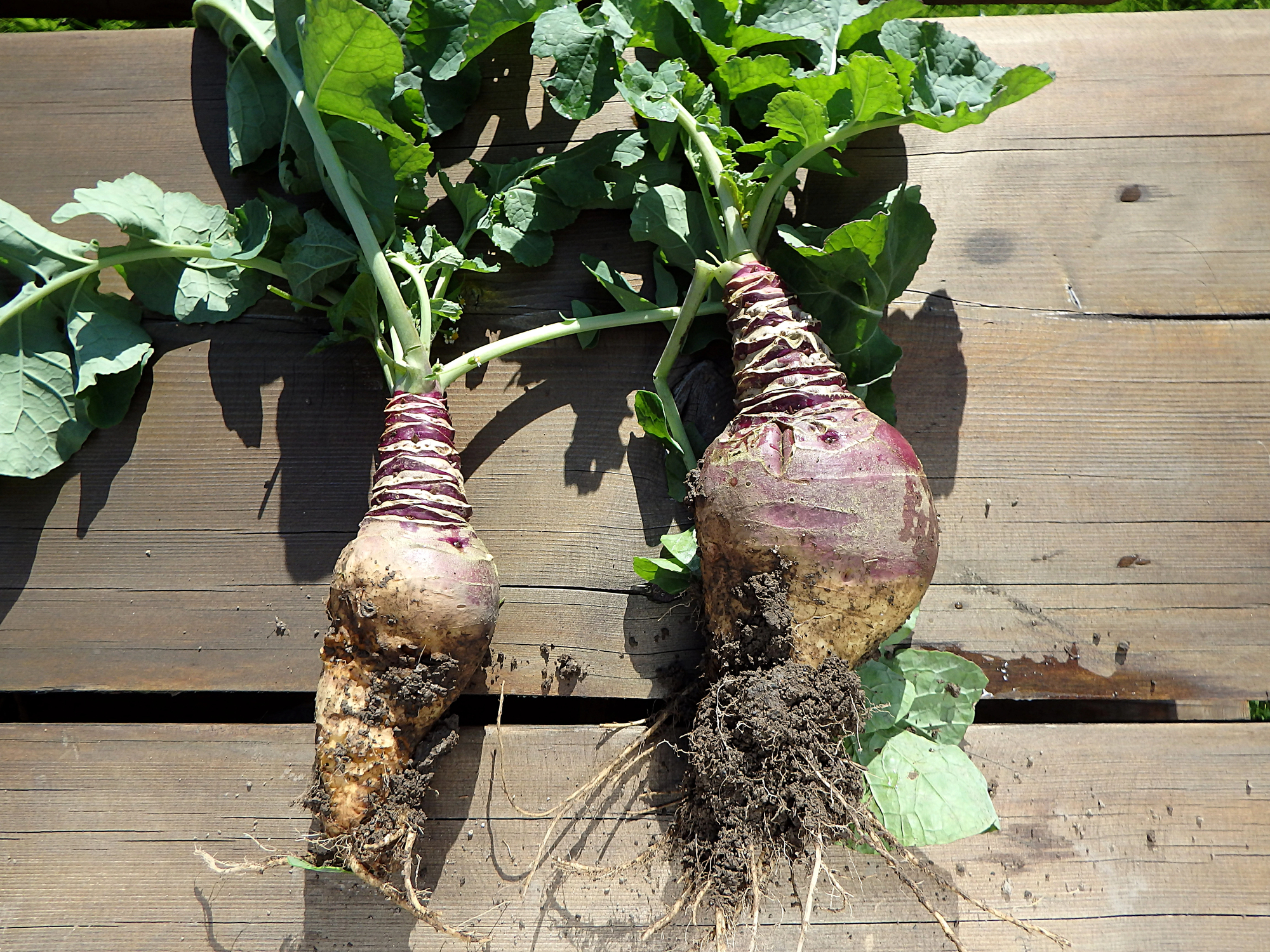Rutabaga Donation Tracker
Quick Links: How & Where to Grow | Temperature | How to Care For | Harvest Signs | Harvesting | Pests | Companions | Flavor | Preservation | Recipes | Michigan Tips | Fun Facts
🌱 How & Where to Grow Rutabagas:
- Direct sow seeds ½ inch deep mid-June to mid-July when soil is 40°F+ for fall harvest (90-100 days).
- Space seeds 4-6 inches apart in rows 18-24 inches apart.
- Thin seedlings to 6-8 inches when they reach 4 inches tall – use thinnings in salads for a peppery kick!
- Sunlight: Full sun (6-8 hours of direct sunlight), tolerates light shade.
- Soil Type: Rutabagas prefer deep, well-drained soil with a pH of 6.0 to 6.5.
- Soil Amendment: Work in 2-3 inches of compost before planting to improve heavy clay soils and ensure proper root development
Unlike turnips, rutabagas are typically grown as a single fall crop due to their long maturity time.
🌡️ Temperature Guidance:
Single planting season. Plant 90-100 days before first hard frost.
- Plant when soil temperature reaches 40°F or higher.
- Optimal growing: 50-65°F.
- Rutabagas need a long, cool growing season – they won’t mature properly in hot weather.
- They can withstand light frosts and actually develop better flavor after exposure to cold.
In Michigan, the sweet spot for planting is mid-June through mid-July for a perfect fall harvest!
💧 How to Care for:
- Consistent Moisture: Maintain even soil moisture throughout the growing season.
- Watering: Provide 1-1.5 inches of water weekly, more during dry spells.
- Mulch: Apply 2-3 inches of organic mulch to retain moisture and suppress weeds.
- Fertilizer: Side-dress with compost or balanced fertilizer (10-10-10) midway through growth.
- Boron: Critical for rutabagas – deficiency causes brown heart. Apply borax if soil test shows deficiency.
📏 Harvest Signs:
Softball-sized (3-4 inches). Best after frost. Can stay until hard freeze.
- Rutabagas are sweetest after several light frosts have converted starches to sugars.
- The purple shoulders will be clearly visible above the soil line when ready.
- Unlike turnips, rutabagas can grow larger without becoming woody – up to 5-6 inches is fine.
Don’t rush the harvest – rutabagas improve in flavor the longer they stay in cool soil!
🧺 Harvesting:
Use spading fork – don’t pull. Remove tops immediately.
- Always dig carefully as rutabagas grow deep and can break if pulled.
- Harvest on a dry day when soil isn’t muddy for easier cleaning.
- Cut tops to within 1 inch of the crown immediately to prevent moisture loss.
- Leave a few in the ground – they can survive into December with heavy mulch!
🪲 Michigan Pests:
Brown heart (boron deficiency), root maggots, club root (rotate crops).
- Brown heart creates water-soaked brown areas in the center – prevent with boron applications.
- Root maggots are the most serious pest – use row covers and rotate away from brassica areas.
- Club root causes swollen, distorted roots – maintain soil pH above 6.2 and rotate crops for 7 years.
- Flea beetles may attack young plants but are less problematic than with turnips.
🫱🏽🫲🏼 Companions:
Good with peas, onions.
- Avoid other brassicas.
- Rutabagas benefit from nitrogen-fixing peas planted earlier in the season.
- Onions and garlic help repel root maggots and other pests.
- Nasturtiums planted nearby act as trap crops for aphids.
- Never follow or plant near cabbage, broccoli, cauliflower, or other brassicas.
🍴 Flavor:
Sweet, earthy, yellow flesh. Milder than turnips after frost.
- Raw rutabagas have a crisp texture with a slightly bitter, cabbage-like flavor.
- Cooked rutabagas become sweet and buttery, especially after frost exposure.
- The yellow-orange flesh indicates higher beta-carotene content than turnips.
- Texture is denser and less watery than turnips, making them perfect for mashing.
- The sweetness intensifies with storage, making winter rutabagas a treat!
🫙 Preservation:
Excellent storage – 4-6 months at 32-40°F. Freeze blanched cubes.
- Root cellar storage is ideal – layer in damp sand or sawdust at 32-40°F with 90-95% humidity.
- Can store in perforated plastic bags in the refrigerator for 2-3 months.
- Wax coating (like store-bought) helps prevent moisture loss during storage.
- Blanch cubed rutabagas for 3 minutes before freezing.
- Dehydrate thin slices for rutabaga chips.
- Pickle young rutabagas with mustard seeds and turmeric.
🧑🏽🍳 Recipes:
Mashed rutabagas, rutabaga gratin, Swedish rotmos.
- Classic mashed rutabagas with butter and cream rival any potato dish!
- Try rutabaga “hash browns” – grate and pan-fry until crispy.
- Swedish rotmos combines rutabagas with potatoes and carrots for traditional comfort food.
- Roasted rutabaga wedges with maple syrup and rosemary are addictive.
- Add cubed rutabagas to hearty winter stews and pot roasts.
✋🏼 Michigan Tips:
- Plant after consistent 50°F soil.
- Excellent for cool fall weather.
- Time planting carefully – rutabagas need 90-100 days, so count back from your first hard frost.
- Michigan’s long, cool falls are perfect for developing sweet, large rutabagas.
- Consider succession planting 2 weeks apart in June for extended harvest.
- Heavy clay soils may need raised beds for proper root development.
❄️ Overwintering:
- Rutabagas can survive in the ground through early winter with proper protection.
- Apply 6-12 inches of straw mulch after the ground starts to freeze.
- Cover with row cover or old blankets for additional insulation.
- Mark rows with tall stakes before snow cover.
- Harvest on mild days when soil thaws slightly.
- In zone 6b, they may survive all winter with heavy protection.
🧠 Fun Facts:
- Cross between turnips and cabbage.
- Called “swede” in many countries.
- Rutabagas were developed in the 17th century, possibly in Bohemia or Scandinavia.
- The name comes from Swedish “rotabagge” meaning “root ram.”
- During World War I, rutabagas became a last-resort food in Germany, leading to the winter of 1916-17 being called “Steckrübenwinter” (rutabaga winter).
- They contain more vitamin C than oranges when fresh!
- The world record rutabaga weighed 85 pounds 12 ounces, grown in Alaska.
- Michigan’s Swedish and Finnish immigrants brought rutabaga traditions that still influence local cuisine today.


0 Comments